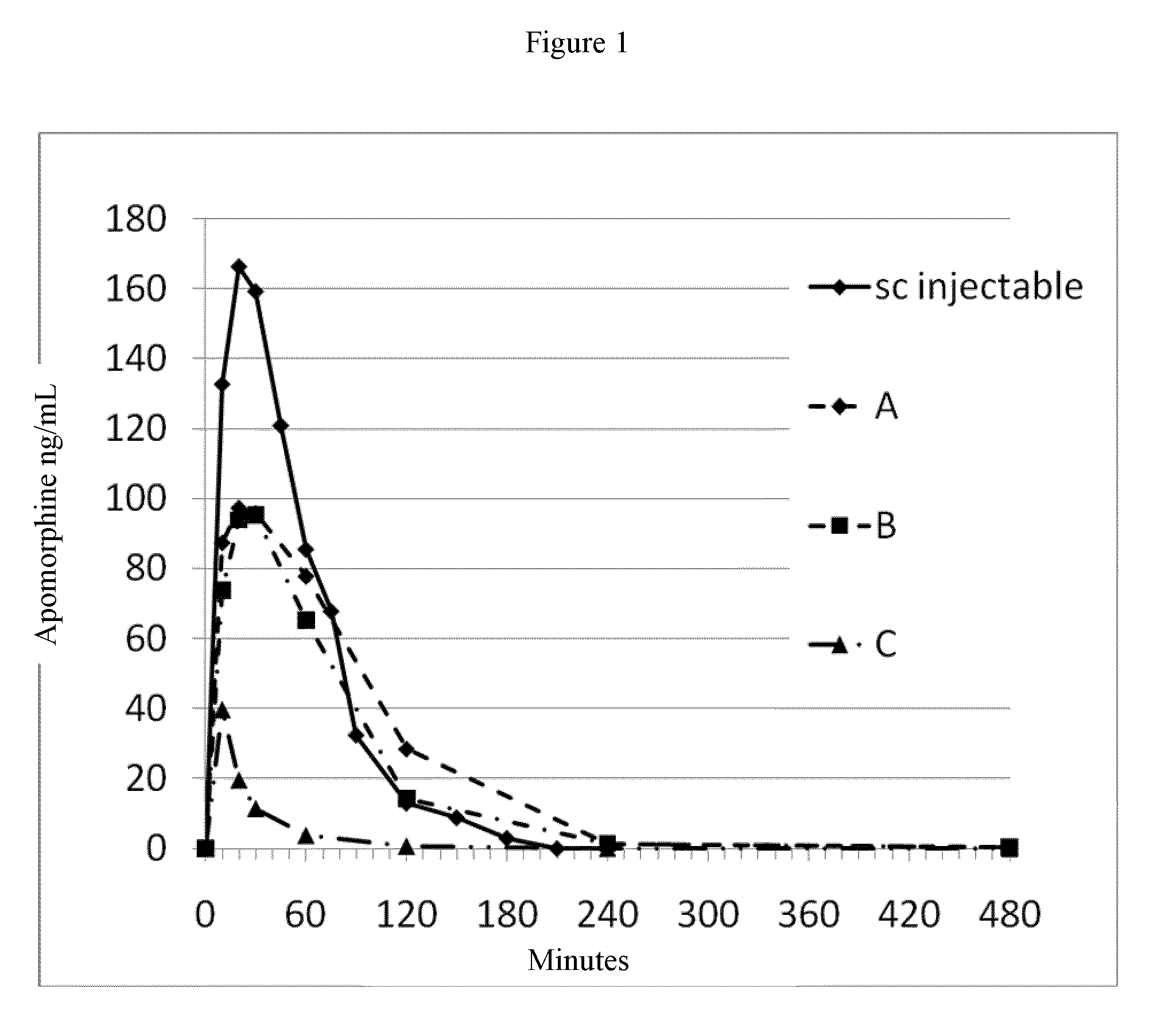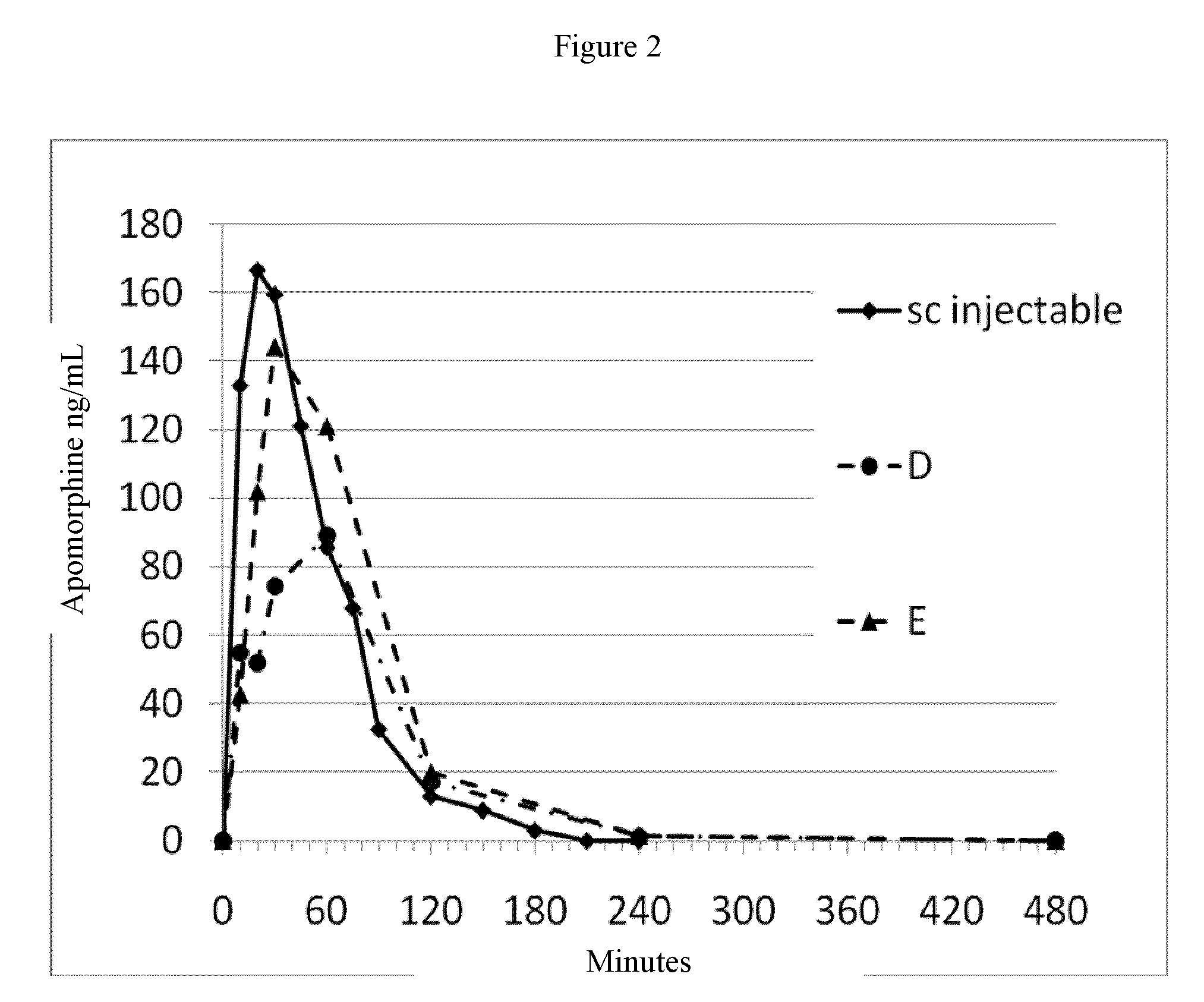Sublingual films
a sublingual film and dopamine technology, applied in the field of sublingual films, can solve the problems of increased stiffness of voluntary skeletal muscles, inability to move and move, resting tremors, etc., and achieve the effects of alleviating akinesia, and reducing skeletal muscle stiffness
- Summary
- Abstract
- Description
- Claims
- Application Information
AI Technical Summary
Benefits of technology
Problems solved by technology
Method used
Image
Examples
example 1
[0148]Films A-H, J, K, and L were prepared as described below. Films A-H were prepared using a solid particulate apomorphine hydrochloride having an effective particle size in the range of 125 μm to 250 μm. Films J, K, and L were prepared using a solid particulate apomorphine hydrochloride that was processed to produce an effective particle size of about 8 μm. For Films J, K, and L apomorphine hydrochloride was milled using a Jet-Pulverizer 2 Micron-Master cyclone discharge mill with stainless steel liner. Nitrogen was used as the process gas at a pressure of 100 PSI and temperature of 25-45° C. The apomorphine hydrochloride was fed into the mill using a “V” groove vibratory feeder and recovered in an integrated bottom collector to reduce material loss associated with a dust bag collector. The design of this milling unit is described in U.S. Pat. No. 3,559,895.
[0149]Film A.
[0150]Film A is a monolayer film containing the components and amounts listed in Tab...
example 2
[0198]Food was withheld from the animals for a minimum of 12 hours prior to study initiation and four hours post dose. Prior to dosing, animals were weighed and assigned to experimental groups, stratified according to body weight. Animals manifesting poor or irregular appetite prior to study were excluded. For sublingual administration of the test article, animals were placed in induction chamber and anesthetized with isoflurane using a face mask. The test article was placed under the tongue and the animal's mouth was closed, while it was also maintained under anesthesia. Five minutes post administration, the animal was released. Blood samples were collected predosing, and at 10 minutes, 20 minutes, 30 minutes, 1 hour, 2 hours, and 4 hours post test article administration via a percutaneous catheter in the auricular artery. Blood samples were stabilized and kept cold until analysis. Bioassays were performed using C18RP-HPLC-MS. PK parameters for various formulations ...
example 3
Dispersed Milled Apomorphine in Bilayer Film
[0212]Using methods analogous to those described in Example 1, a jet-milled powder of apomorphine hydrochloride (D95<20 μm) is added, along with the other components of the apomorphine layer, to a mixture of ethanol and ethylacetate to create a homogeneous dispersion. The mixture is spread on a thin plastic liner and dried to produce a film. This film can be administered as is or combined with a neutralizing layer as per Example 1. Also contemplated, is the addition of jet-milled pH neutralizing agent to the neutralizing layer either for inclusion with the apomorphine (i.e., to produce a single layer wherein both active apomorphine hydrochloride and a neutralizing agent are dispersed as solid agents within a single layer), or to a neutralizing layer (i.e., to form a bilayer film).
PUM
| Property | Measurement | Unit |
|---|---|---|
| pH | aaaaa | aaaaa |
| concentration | aaaaa | aaaaa |
| concentration | aaaaa | aaaaa |
Abstract
Description
Claims
Application Information
 Login to View More
Login to View More - R&D
- Intellectual Property
- Life Sciences
- Materials
- Tech Scout
- Unparalleled Data Quality
- Higher Quality Content
- 60% Fewer Hallucinations
Browse by: Latest US Patents, China's latest patents, Technical Efficacy Thesaurus, Application Domain, Technology Topic, Popular Technical Reports.
© 2025 PatSnap. All rights reserved.Legal|Privacy policy|Modern Slavery Act Transparency Statement|Sitemap|About US| Contact US: help@patsnap.com



